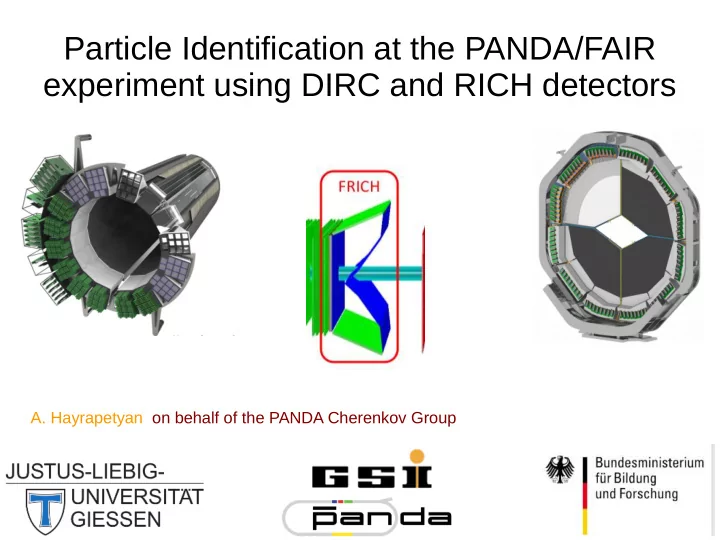

Particle Identification at the PANDA/FAIR experiment using DIRC and RICH detectors A. Hayrapetyan on behalf of the PANDA Cherenkov Group
Facility for Antiproton and Ion Research FAIR http://www.fair- center.eu/
Facility for Antiproton and Ion Research FAIR
PANDA Objectives Nucleon structure Transition Distribution γ , e , μ , π Spectroscopy γ , e , μ , π , k Amplitudes Narrow XYZ states Drell Yan Process Exact measurement of Time-like form factors their widths Detector Hypernuclear physics Double Λ hypernuclei Strange Baryons Hadrons in nuclei γ , π , k, p Spectroscopy, γ , π , k, p Charm and strangeness Polarisation In the medium
PANDA Objectives In all cases practically one needs to have PID For all species ( γ, e, μ, π, k, p) As the kaon identification is the most challenging , here their anticipated phase space Spectroscopy Nucleon structure P=3.5 GeV/c P= 15.0 GeV/c Narrow XYZ states Transverse Distribution Exact measurement of their Amplitudes widths Drell Yan Process Time-like form factors Hypernuclear physics Double Λ hypernuclei Strange Baryons Hadrons in nuclei Spectroscopy, Charm and strangeness Polarisation In the medium
PANDA Objectives Details see here In all cases practically one needs to have PID For all species ( γ, e, μ, π, k, p) arXiv:0903.3905v1 [hep-ex] As the kaon identification is the mos challenging , here their anticipated phase space from PANDA benchmark reaction channels Spectroscopy Nucleon structure Narrow XYZ states Transverse Distribution Exact measurement of their Amplitudes widths Drell Yan Process Time-like form factors Hypernuclear physics Double Λ hypernuclei Strange Baryons Hadrons in nuclei Spectroscopy, Charm and strangeness Polarisation In the medium
The PANDA detector Barrel DIRC FRICH Endcap Disc DIRC
The PANDA Cherenkov Detectors Barrel DIRC FRICH Endcap Disc DIRC(EDD) Polar Angles 22-140 0-5(10) 5(10)-22 degree Goal 3 s.d. p /K separation 3 s.d.π/K 2÷10 GeV/c 3s.d. p /K Up to 3.5 GeV/C μ/π possible till ~2.0 GeV/C up to 4.0 GeV/C
The BARREL DIRC ● See Jochen Schiwening talk in this session
The Forward RICH as predecessor, 20 years ago The principle in our HERMES Experiment T.Iijima et al., NIM A548 (2005)383 A.Yu.Barnyakov et al., NIMA553(2005)70 The HERMES RICH detector HERMES Collaboration NIMA v. 433. Issues 1-2 (1999) 98-103 A few layer of Aerogel, Mirrors and Photon detector area outside of acceptance See A. Barnyakov talk next for more
The Prototype of FRICH tested at BINP and CERN Aerogel produced at BIC SB RAS in cooperation with BINP Novosibirsk Photon detector , Philips Digital Photon Counting (PDPC) https://www.digitalphotoncounting.com
The FRICH Prototype results Ring 2D distribution for P=6 GeV/C(left) and ring radius distribution for P= 1 GeV/C Momentum beam measured by FRICH prototype at CERN T9 test beam
Novel Endcap Disc DIRC(EDD) will be built by Giessen http://www.uni-giessen.de/dueren
The working principle θ p γ Quartz X γ θ c φ cos(θc) = sin(θp) cos(Φ)cos(φ) + cos(θp)sin(φ) One can calculate the Cherenkov angle analytically, hence EDD could be a part of online trigger at any level
The frst full size EDD prototype at CERN T9 PID probabilites Pion, muon,electron Proton missidentification missidentification Number of Photons Number of Photons radiator made of foat glass • One can see that by enough hits FELs made of acrylic glass • the misidentification is then negligible photo sensors: MA-PMT with 16 strips • mixed hadron beam at CERN •
The hit pattern shows what we call “SMILE” Pion, muon,electron Proton Pixel Number ----> PMT Number ----> PMT Number ----> One sees that Protons are more happy than Pions&Co
Moving in EDD final design direction Radiator Borofloat Glass ---- fused Silica FEL Plexiglas Quartz with prism With optic bonding Photon Detector MaPMT(16 channels)---MCP-PMT (>=300 channels) Readout FEE FPGA based channels (256 single edge, 192 with ToT) TOFPET ASIC compact TRB3 design 8X128=1024 channels
New prototype finer scaling new “SMILE” Single γ resolution “mimicking” full prototype
The importance of the Filter In Silica produced Cherenkov Photons Number Against wavelength –> Pions Kaons Protons Cherenkov angle against momentum λ um
The Endcap DIsc DIRC design Full Weight ~ 450 kg For 1 Quadrant ~ 85 kg Quadrants 4 ROMs 96 = 4X3X8 (Readout Modul) Photon detection area ~600cm 2 FELs 288 = 4X3X8X3 (Focusing Element) Readout Channels ~30k free running readout system Wavelength Filters ~ 100 or New “green” photocatode MCP We are waiting ~22 detected hits (per track) We promise >3 s.d. for π/K separation till 4 GeV/c momentum
The EDD Read Out Module In design or in Prototype(in 3d printed housing)
EDD final design Finalizing the specifications , algorithms, TDR for a EDD Quadrant readiness for Phase1, 2018 new Testbeam at T9 The complete design in CAD
The Time-lines FRICH EDD Barrel DIRC 2018 TDR expected 2018 R&D fine tuning 2018 component procurement 2018-2021 1st Quadrant 2019-2021 bar box and readout module Mirror layout optimization production Assembly in 2D 2022-2023 Installation of 2022-2023 installation in PANDA MC simulation First Quadrant Hall PANDAROOT 2023-2024 commissioning 2023-2024 commissioning with cosmic Aerogel Optimization and beam 2025 completion of remaining Photon detector 3 Quadrants TDR approved(arXiv:1710.00684) investigation
Շնորհակալություն Ուշադրության համար Thanks for your attention Danke für ihre Aufmerksamkeit Спасибо за внимание
Recommend
More recommend